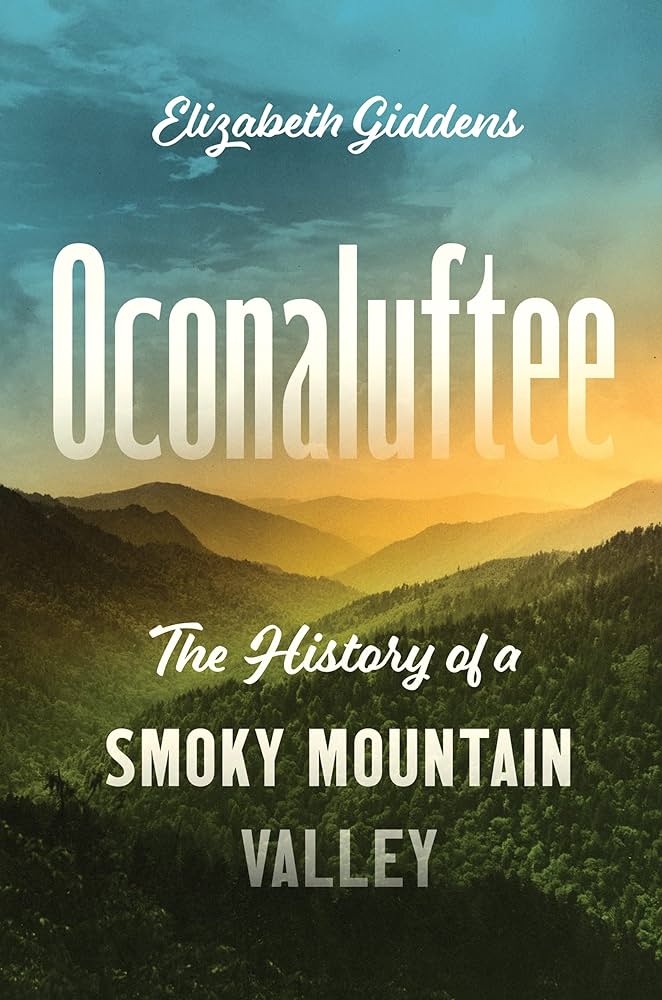“Like a Quilt, a Patch at a Time”:
Q & A with Dr. Beth Giddens, author of Oconaluftee: The History of a Smoky Mountain Valley.

KENNESAW, Ga. (Feb 2, 2024) — Written by Gabrielle Punzalan, edited by Jenny Rissen, interview by Kris Roberson
Oconaluftee: The History of a Smoky Mountain Valley by Kennesaw State University’s Professor of English, Dr. Elizabeth Giddens was published by the University of North Carolina Press in April 2023. It documents the history of the valley that encases the Oconaluftee River. The valley extends east from the North Carolina side of Newfound Gap at the crest of the Smokies, through Smokemont and Cherokee to the confluence of the Oconaluftee and Tuckasegee Rivers near Ela, North Carolina.
The book has been well-received. In H-Net Reviews, Ian Hartman (University of Alaska) praised it as “well-researched and deeply considered … an evocative book that successfully keeps the focus on the people who made Oconaluftee their home even as it keenly explores the momentous forces that in turn threatened, impoverished, and sometimes, enriched, a diverse cast of mountain families.” Smoky Mountain Times called it "a model of its genre—deeply and widely researched, beautifully organized, nicely illustrated… By any standard of measurement it is something of a landmark volume, with its overall quality and depth appreciably exceeding that of any previously published work."
In the following Q&A, Dr. Giddens discusses her research and publication process with members of the KSU English communications team:
Q: When and why did you start pursuing this research? Has this been a long time in development, or is this a more recent project?
Dr. Giddens: It has been a long process but a rewarding one… I began research for the book in the fall of 2010 and completed the first draft in mid 2017… In 2020, I was given an advance contract from the University of North Carolina Press, and the book was sent to peer reviewers. By the end of 2022, the reviewers had accepted a revised manuscript, and work was begun on selecting photographs and securing permissions and scans; then came final revisions, copyediting, proofreading, and indexing.
Q: What is most important for people to know about Oconaluftee: The History of a Smoky Mountain Valley?
Dr. Giddens: The valley’s human history shows how groups of people can coexist as neighbors. It reveals that no one is entirely removed from national and international events and trends and that to survive a community needs to recognize changing times, adapt, maintain its core identity, respect others, and develop mutually supporting reciprocal relationships.
Q: How would you describe yourself as a scholar/researcher?
Dr. Giddens: I like to learn how people respond to challenges. When faced with political, cultural, economic, or environmental change, a community has some options, but not unlimited ones. Often, people must adapt. How they adapt makes a difference. Are they displaced, or do they find ways to survive and strengthen their community? My interest is in learning what choices individuals and groups made based on how they understood their circumstances and options… Usually, by building an understanding of historical peoples’ circumstances through research, I can make reasonable inferences about options and outlook.
Q: What has the research and writing process of Oconaluftee: The History of a Smoky Mountain Valley been like for you? Did you travel to complete your research, did you immerse yourself in texts, etc.?
Dr. Giddens: Since I was a child, I have visited the Great Smoky Mountains National Park and Cherokee, North Carolina, so I have traveled in the [Oconaluftee] valley for many years. When I learned that no [written] history of the whole valley existed, I realized this extraordinary and beautiful place was unsung. Though other scholars have focused on Cherokee history and on the park, an account of the valley itself and all of its residents—Cherokee, white, and Black—did not exist.
Once I began work on the project, I traveled to the [Oconaluftee] valley and learned more about the area as it exists today. On average, over the last twelve years, I have visited the valley three times each year for a week or more. I interviewed descendants of residents. I observed archeological field work and attended an annual reunion of Smokemont Baptist Church, a community center. I visited locations in the park and in Cherokee, NC, that had been and are still important to the valley’s history. I drove around, stopping at many spots I had read about and wanted to see. I hiked trails to the sites of homesteads and cemeteries.
Of course, I also read everything I could that was relevant to the history of the [Oconaluftee] valley: published accounts and materials from archives at the park, the Museum of the Cherokee People, Western Carolina University at Cullowhee, and other libraries. My research was a slow process of accretion of facts, details, insights. I studied online census data; property records; marriage, birth, and death certificates; military records—anything I could find to pin down a name, date, fact, detail. Then I pieced a story together in elaborate notes, chronologies, and outlines, like a quilt, a patch at a time… I worked on one historical period at a time, first doing the research, then drafting a chapter. After peer review, I revised a couple of the chapters and added headnotes.
This account is, obviously, too neat; in truth, though I always focused on one period, I was continually learning more about the entire sweep of time. Consequently, I updated the manuscript as I learned more and more. It was a recursive, corrective, additive process. Many things I thought I knew early on were amended as my knowledge of the valley deepened.

Dr. Giddens: The book surveys the human history of the [Oconaluftee] valley from prehistory to 1940, when the Great Smoky Mountains National Park was formally dedicated, a date which marked the end of private ownership of land by the white farm families.
An early reader wisely noted that the book needed more about the experience of being in the [Oconaluftee] valley today, so I added present-day headnotes to the chapters that comment on places of historical significance and are easy to visit. These were a joy to write. I hope they provide readers with ideas for sightseeing as well as ways to connect the valley’s history to the present moment. My favorite headnote is about Mingus Mill and the nearby cemetery of people who were enslaved in the valley; it appears at the start of the chapter about the lives of Black and multiracial people after the Civil War.
Q: How do you hope Oconaluftee: The History of a Smoky Mountain Valley will draw attention to or innovate on its subject? How does it add to the conversation on Appalachian history and culture?
Dr. Giddens: Previous accounts of the [Oconaluftee] valley focus on the Eastern Band of the Cherokee Indians or on the white families separately—with scant mention of the few enslaved people and their descendants, except, perhaps, of Charles Mingus, the jazz bassist who was a scion of the Mingus family. My project attempts to tell the story of all three groups together, showing how and when they were neighborly despite sharp asymmetries in political power and wealth. At key moments, the Cherokees and the white folk assisted each other, enabling each group better prospects than they would have had otherwise. They were not integrated; they were neighborly. The history of the national parks is often about the dispossession of Indigenous peoples, but in Oconaluftee that did not happen, entirely. Understanding why it did not is valuable. The story shows that individuals can form reciprocal relationships across social boundaries and that these relationships can have far-reaching effects.
Q: How do you see your role as a professor interacting with your goals in research and scholarship? What do you see your research bringing to the English Department, both undergraduate and MAPW?
Dr. Giddens: Students benefit when their teachers can share their own experiences in developing projects and working as professionals. I teach the things that I’ve done: organizational writing, proposal writing, research methods, editing, technical writing, environmental writing, feature writing, and now history.
Q: What is the most important thing you want readers to take away from reading Oconaluftee: The History of a Smoky Mountain Valley?
Dr. Giddens: The overarching message of the book to me is the value of community and of neighborliness among households and groups. I think that the pandemic showed our society this message too. It’s a good idea to know your neighbors and to have reciprocal relationships of care and friendship with them. Those relationships make you more resilient in times of stress and change, and they add meaning and joy to life.
Many thanks to Dr. Giddens for her time in discussing her work, and to KSU English student communications team members Kris Roberson and Gabrielle Punzalan for facilitating the Q&A discussion!
CITATIONS
Ian Hartman. Review of Giddens, Elizabeth, Oconaluftee: The History of a Smoky Mountain Valley. H-Environment, H-Net Reviews. October, 2023.
Jim Casada. “New Work on Luftee and Other Books Looking at Park History—Part 1,” Smoky Mountain Times. 1 June 2023, n.p.











